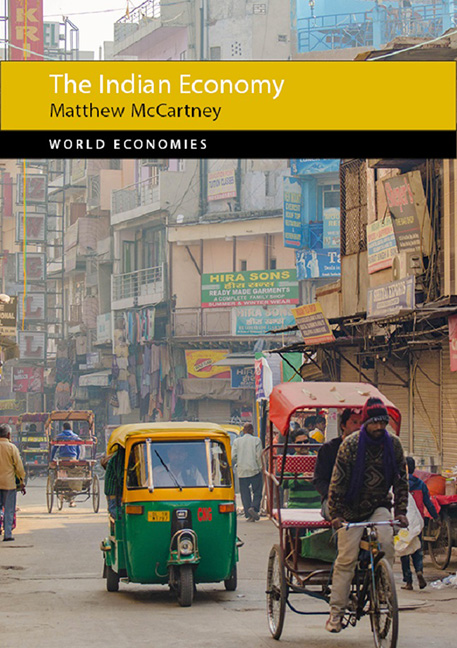Book contents
- Frontmatter
- Dedication
- Contents
- Acknowledgements
- List of Tables and Figures
- Maps
- 1 Introducing the Indian economy, 1947–2017
- 2 The Indian economic story since 1947
- 3 Measuring economic and human development
- 4 The form of the Indian economy
- 5 Human factors in the Indian economy
- 6 Making the Indian economy unique
- Conclusion: prospects for the Indian economy
- References
- Index
2 - The Indian economic story since 1947
Published online by Cambridge University Press: 09 August 2023
- Frontmatter
- Dedication
- Contents
- Acknowledgements
- List of Tables and Figures
- Maps
- 1 Introducing the Indian economy, 1947–2017
- 2 The Indian economic story since 1947
- 3 Measuring economic and human development
- 4 The form of the Indian economy
- 5 Human factors in the Indian economy
- 6 Making the Indian economy unique
- Conclusion: prospects for the Indian economy
- References
- Index
Summary
This chapter presents a snapshot of the Indian economy in 2017, and discusses some of the key influences on the economy (the constitution, the federal system and the central bank). The chapter then offers an unfolding narrative to reveal the origins of the 2017 snapshot, considering variously inflation, trade, agriculture, remittances and episodes of economic growth since 1947.
THE INDIAN ECONOMY IN 2017
In 2017 in terms of total GDP, India is the world’s seventh-largest economy, similar in size to either France or Italy. By 2050 it is forecast to be the world’s second largest, having overtaken the United States and remaining only behind China. According to the 2011 Census India had a population of 1.21 billion, which is likely to have increased to 1.34 billion people by 2017, and by around 2024 it should overtake China (1.39 billion in 2017). In 2017 India had a GDP per capita of around $2,000 which put it at the bottom of the middle-income countries in the world. In PPP (purchasing power partity) terms (which adjusts for cost of living) India’s per capita GDP was $7,170 in 2017 which put it 126th in the world. In 2017 the Indian economy had experienced several years of 7 per cent annual growth, which was among the world’s fastest, and after nearly forty years of lagging behind China was just about faster. This rate was forecast to continue into the near future. This growth has been led by the service sector where India has become the world’s largest base for technology startups, with more than 1,400 founded in 2016 alone.
Recent economic growth looks to be sustainable. India’s domestic debt was around 70 per cent of GDP and foreign debt around 21 per cent of GDP, both had been stable or slowly declining over the years up to 2017. The inflation rate was around 4 per cent and had been steadily declining over the previous few years. India’s export growth had been slowly declining over the years immediately before 2017, but the country had seen its oil import bill cut by almost $80 billion due to lower oil prices, which allowed the overall balance of payments to show some improvement.
- Type
- Chapter
- Information
- The Indian Economy , pp. 43 - 92Publisher: Agenda PublishingPrint publication year: 2019



